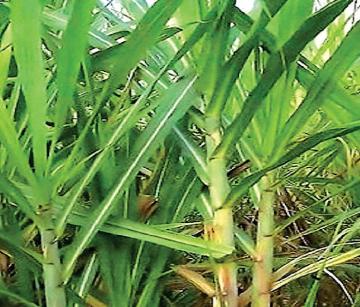
Sugarcane bagasse
Sugarcane bagasse (the fibrous portion which leaves the last processing stage of the sugar mill) is the residue of sugar cane stalks after the juice has been pressed out in the factories and mainly two varieties are available viz. (i) fine bagasse and (ii) coarse bagasse. The fibre which leaves the last processing stage of the sugar mill contains roughly 50% moisture and 1.5-4% sucrose. It is passed through rotary sieves to remove fine particles (bagasse pith or bagacillo) which may be used as a filter aid later in the process.
Nutritive value
The chemical composition of fine and coarse varieties depend on the place of production. The nutritive value of fine and course varieties being, CF 36.52-42.1% and 40.49-43.22%, EE 0.52-1.68% and 0.53-0.87%, ash 2.60-3.49% and 1.81-2.58%, NFE 51.95-54.8% and 50.39- 54.54% respectively. It contains 3.5% CP and 35% TDN.
Deleterious factor
The low digestibility, high lignin (>20%) and very low nitrogen content of raw bagasse limit its inclusion in feeds.
Detoxification
Nutritive value of bagasse and bagasse pith can be improved by various ways like pre- digestion by chemical and physical methods and mixing readily available sources of carbohydrate (molasses) and nitrogen or protein. Chemical treatments include alkali (sodium hydroxide) and ammonia (gas) or urea treatment. In order to convert urea to ammonia, a source of urease may be necessary for this more inert fibrous residue. The ground seed of jack-bean (Canavalia ensiformis) is being used commercially for this purpose (AFRIS, FAO). In NaOH treatment, 12% NaOH solution is mixed for 5 minutes with the pith before adding 10% molasses-urea. It improves digestibility from 20 to 50% (AFRIS, FAO).
Physical treatment to increase digestibility which appears to have application on an industrial scale is the use of steam at high pressure. Treatment of bagasse with high pressure steam (14 kg/cm) for 5 minutes raised dry matter digestibility from 28 to 60% (rumen nylon bag method, 48 hr incubation), (AFRIS, FAO).
Inclusion
Bagasse and bagasse pith are often used as fillers in compound diets and as carriers for molasses or molasses-urea mixture.
